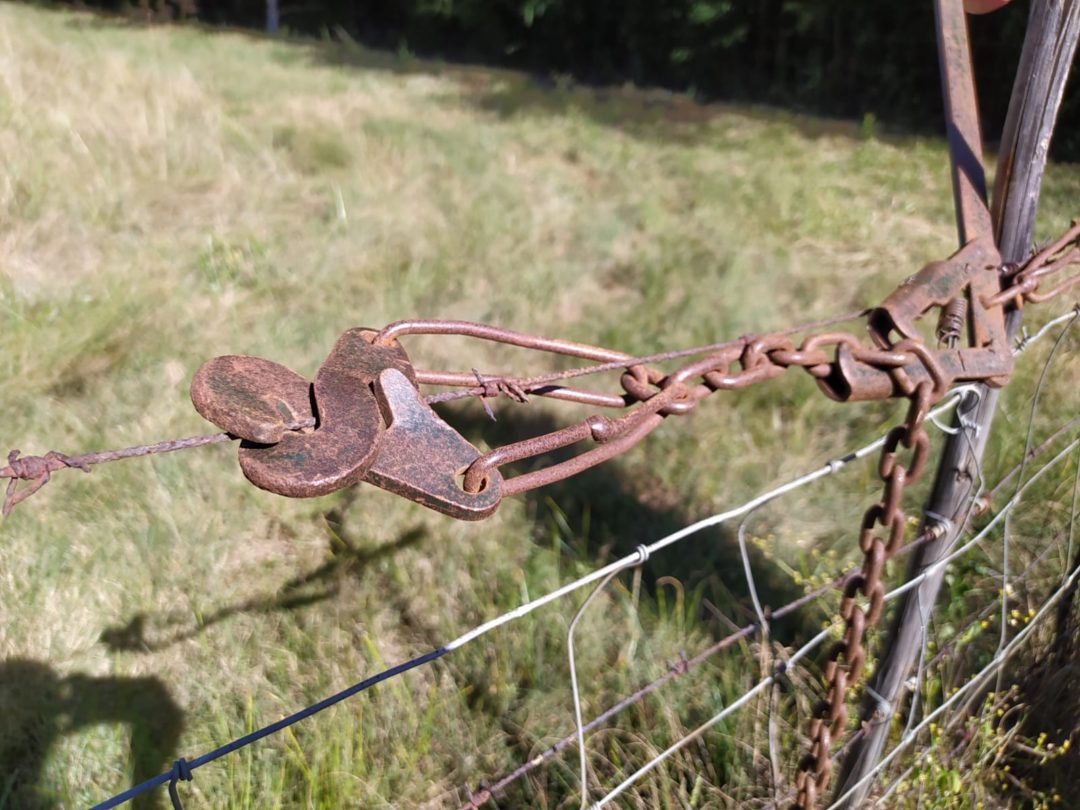This is part four in the series In the Workshop: Tools & machinery. For more, click here.
There are some hand and power tools that will find their way into a smallholder’s toolkit that one won’t find in that of a townie.
Two have to do with fencing, one with irrigation piping and the last with both fencing and farming.
Fencing Tools
Most plots will have wire fencing, either of horizontal plain stranding, possibly electrified, or of barbed wire, not electrified, or of sheep or game fencing, or of diamond mesh, which is a combination of mesh and horizontal wires.
In all of these cases, the key to a good, strong, and long-lasting fence is taut wiring, and the best way to achieve this is by using a wire strainer.

A very old design of strainer is the Donald’s “Bobbejaan” a device which combines two interlocking sets of clamps one set of which is attached to a length of chain and a hand-operated ratchet.
To join two pieces of wire tautly the sets of interlocking clamps are placed on each of the wires, a few centimetres from the ends. The chain is then placed into the ratchet, which is then ratcheted up until the required tension is reached.
The two ends can then be pulled together and joined, and when the clamps are released the wire will be suitably taut along its length.
The problem with the “Bobbejaan” is that the tool itself, ie the chain and ratchet gets in the way of the ends being joined, which means a certain amount of fumbling about with other tools to make a tight join.
A newer design, from Australia, leaves a clear work area in which the end can be worked for the join. A problem with this design, however, is that the work area is relatively small, which makes swivelling pliers and the like unnecessarily difficult.
A refinement of this device, however, has been designed by the ever-inventive Michris Janse van Rensburg of Backsaver Implements. His design uses the same principle, but adds a set of clamps on a length of chain, which enables a bigger work area.
The other vital fencing tool for stranded fences is the most simple device anybody could wish for. It is no more than a 10cm or 15cm length of flat iron bar, drilled with a hole in one corner and another in the middle of one side. This is used for twisting the ends of wires around each other, for example when fastening off the end of a strand to a post, or when attaching a strand to a dropper of Y-standard.
Irrigation Tools

Most farms and smallholdings will have lots and lots of LDPE water piping buried in trenches to take water to paddocks, into vegetable patches, and to fill tanks etc. And every time these pipes need valves fitted, or joins, or bends, there must be a strong clamp. These can be shop-bought metal screw-clamps, correctly called jubilee clamps, or they can be clamps made out of galvanised wire.
One such clamping tool was designed by a retired SA Railways engineer and manufactured at his Pretoria North home, and is named a Cortool. They are commonly sold by their hundreds at agricultural shows.
Other designs of wire clamping tools are also available if you look for them.
Farming and Fencing
If you do a lot of fencing, particularly of the post and rail type, or a lot of open field planting, for example of small tree saplings, a post hole driller will be a boon to you.
While there are models that fit behind a tractor and which are driven by the tractor’s PTO, hand-held one and two-man jobs, powered by single-cyliner pull-start engines, are also available.
Commonly, they will come with two diameters of bit, 200mm and 250mm, the efficiency of which will depend to an extent on the soil you are attempting to drill in.

